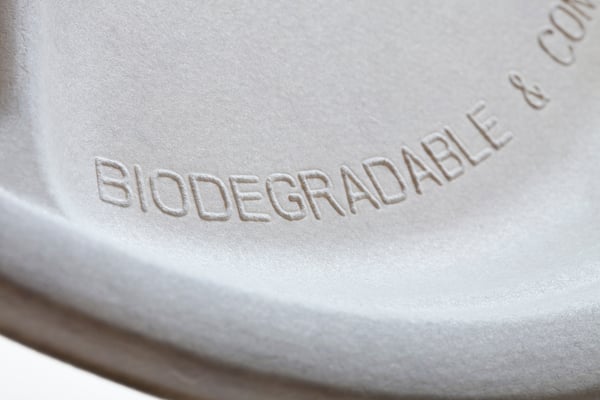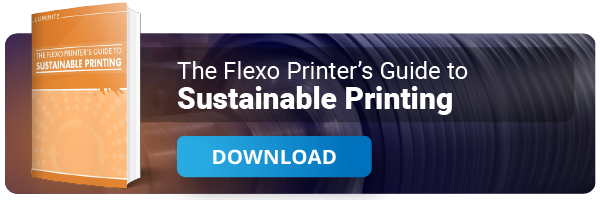Share this
Top 4 List of Sustainable Packaging Materials for Flexo Printing
by Luminite on Aug 19, 2020 10:47:13 AM

Flexographic, or flexo, printing is among the most popular package printing methods, especially for medium-to-long print runs. But with so many consumers choosing to do business with brands that incorporate eco-friendly strategies into their business model, it can pay -- literally -- to be more intentional with your sustainable packaging efforts, especially when it comes to flexo printing.
In this post, we'll take a look at sustainable product packaging -- and how flexo can boost any brand's environmental strategy. Here's a look at the role that flexo plays in several sustainable packaging examples:
List of Sustainable Packaging Materials for Flexo
Any experienced flexo printer knows there are four main components to a good print job. Those include:
- Image carriers & anilox rollers
- Substrates
- Inks
- Coatings and adhesives
And while these components are crucial for the flexo printing process, there are ways to make them more sustainable -- for the environment and your wallet.
1. Image Carriers & Anilox Rollers
What image carrier are you using? Photopolymer plates, maybe?
Did you know that photopolymer plates can be recycled and reused in other plastic products? This is a great way to cut down on waste and save cost for brand-new equipment.
However, photopolymer plates aren’t the bee’s knees in terms of eco-friendliness. Trace amounts of mercury, lead, and other harmful elements are in plates. Often, these chemicals get washed down the drain when exposing the plate.
Integrating a sub-micro mesh filter into the waste water disposal system will go a long way toward reducing environmental impact from photopolymer plates.
But, what if there was a better image carrier that didn’t need so much hand-holding?
Elastomer Sleeves
Elastomer sleeves are an eco-friendly alternative to photopolymer plates, made with a high-quality rubber for longer-lasting print runs. Also, elastomer sleeves ensure a quality print job the first time -- no wasteful second run necessary.
Sustainability goes beyond just ensuring you're using eco-friendly substrates, inks, and more. It’s also about making sure your equipment is working up to its full potential. Elastomer sleeves keep flexo presses running better for longer, while also being:
- Fast and easy to clean
- Long-lasting
- Highly detailed
- Simple to install
Anilox Rollers
Anilox rollers are essential for ensuring an even spread of ink on your image carrier, and they’re often made of steel and a ceramic coating. There aren’t many options for eco-friendly anilox rollers, but that doesn’t mean there’s nothing you can do!
Since the rollers are constantly coming into contact with ink it’s important to clean your rollers, right? Well, how you clean your anilox rollers is where you can make a more environmentally conscious decision.
Common cleaning practices often involve harmful chemicals that release volatile organic compounds (VOCs) and require extensive capturing and filtering systems.
But, there are a few ways to clean anilox rollers that pose a small environmental impact, or none at all! Take water-based chemical cleaning or laser cleaning as examples.
2. Substrates
Looking for a list of sustainable packaging materials? In the case of substrates, there are a bevy of options to choose from these days:
- Recycled sustainable paper packaging
- Recycled plastic
- Bioplastics
- Compostable & biodegradable materials
Don't be scared off by certain plastic films, as an increasing number can be recycled at store drop-off locations.
Spending a bit more time in the design phase is worth it. You might just discover a variety of sustainable substrate options for your packaging.
A caveat: Make sure the material you're using is approved for the product you’re bundling up. For instance, if you’re packaging anything consumable, you'll want to specifically research the most sustainable materials for food packaging.
Other products may have less-rigid standards. Sustainability is important, but make sure the substrate also reflects the product.
3. Inks
Without ink, you wouldn’t have a print. Paying attention to ink choice is the first step to a sustainable flexo printing practice.
If possible, stay away from solvent-based inks, as they tend to contain more volatile organic compounds, or VOCs. These harmful chemicals require extra precautions in your pressroom, which means extra costs.
Water-based inks are more environmentally friendly, and the end result still looks great.
Some inks are curable with ultraviolet light or electron beams. These methods aren’t as popular as using water-based ink, but for printers that want a solvent-less system, hybrid inks are the way to go.
Hybrid inks combine the convenience of water-based inks and the bright shine and resistance of curable inks. However, developing a system with an electron beam is expensive, and might be a long-term goal.
Changing inks may take some reworking of your flexo process because not all image carriers are suited for water-based inks. But, in the end, reducing the amount of harmful chemicals in the air and water is worth the redesign.
4. Coatings and Adhesives
Inks are just one aspect of "greening" your flexo printing process. You'll also want to ensure that you're using sustainable coatings and adhesives.
VOCs are just as much a consideration with adhesives as they are with inks. Typically, synthetic adhesives or coatings will emit more VOCs, so sustainable designers are moving toward more renewable adhesive derivatives.
For example, gluten and casein are effective adhesives, but they’re derived from animal proteins, so some people avoid using them. The most efficient and sustainable adhesives are made from plant proteins, like potato or corn starch. Envelopes use reactive adhesives on the flap, where liquid activates the potato starch, making it sticky.
Also, consider how recyclable your adhesives are. Will they break down without needing to use harmful chemicals?
Flexo Printing Partners for Sustainable Product Printing
Sustainability has become an increasingly popular topic when it comes to flexo printing. Staying on top of this trend will keep your pressroom safe and eco-friendly.
To learn more about how to create a sustainable printing strategy, check out our new ebook!
Share this
- Flexographic Printing (81)
- Image Carrier (28)
- Elastomer sleeves (27)
- Ink Transfer (25)
- Quality (22)
- Flexo sleeve (20)
- News (18)
- printing defects (18)
- flexo printing defects (17)
- sustainability (13)
- Flexo Troubleshooting (12)
- Ink (12)
- Digital Printing (10)
- Flexo 101 (10)
- Flexo Inks, (9)
- Anilox (7)
- Blister Packaging (7)
- Cost (6)
- print misregistration (6)
- regulations (6)
- Corrugated Printing (4)
- pinholing (4)
- "Tradeshow (3)
- Digital Flexo (3)
- Gravure Printing (3)
- Insider (3)
- Load-N-Lok (3)
- Wide Web (3)
- direct laser engraving (3)
- flexo-equipment-accessories (3)
- gear marks (3)
- halo (3)
- testing (3)
- Narrow Web (2)
- bridging (2)
- feathering (2)
- filling in (2)
- mottled image (2)
- pressure (2)
- Labelexpo (1)
- dirty prints (1)
- doughnuts (1)
- embossing (1)
- kiss impression (1)
- October 2023 (2)
- September 2023 (1)
- August 2023 (1)
- July 2023 (3)
- June 2023 (1)
- May 2023 (5)
- April 2023 (1)
- March 2023 (2)
- February 2023 (1)
- January 2023 (3)
- December 2022 (1)
- October 2022 (3)
- September 2022 (2)
- August 2022 (2)
- July 2022 (3)
- May 2022 (1)
- April 2022 (4)
- March 2022 (2)
- February 2022 (5)
- January 2022 (7)
- December 2021 (1)
- November 2021 (3)
- October 2021 (2)
- September 2021 (1)
- August 2021 (1)
- July 2021 (3)
- June 2021 (1)
- May 2021 (4)
- April 2021 (4)
- March 2021 (4)
- February 2021 (2)
- December 2020 (1)
- November 2020 (1)
- October 2020 (2)
- September 2020 (1)
- August 2020 (3)
- July 2020 (2)
- June 2020 (3)
- May 2020 (1)
- April 2020 (1)
- November 2019 (3)
- October 2019 (1)
- August 2019 (1)
- July 2019 (1)
- April 2019 (1)
- March 2019 (1)
- January 2019 (1)
- October 2018 (2)
- August 2018 (1)
- July 2018 (1)
- June 2018 (1)
- February 2018 (2)
- October 2017 (1)
- September 2017 (2)
- January 2016 (1)
- February 2015 (1)
- January 2015 (1)
- December 2014 (2)
- September 2014 (1)
- February 2014 (1)
- January 2014 (1)
- December 2013 (3)
- October 2013 (1)
- September 2013 (1)
- June 2013 (1)
- January 2013 (1)


No Comments Yet
Let us know what you think